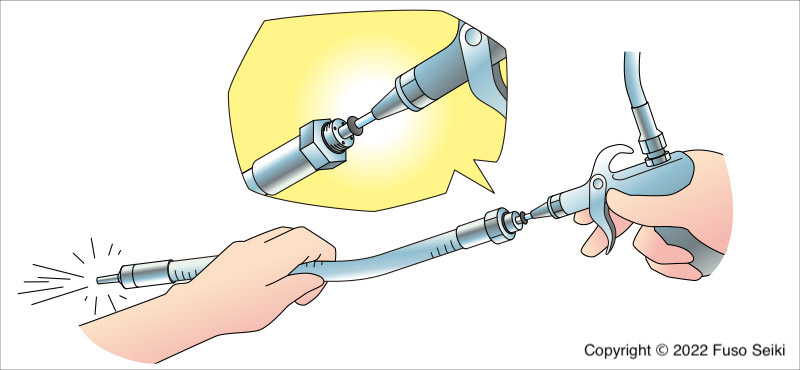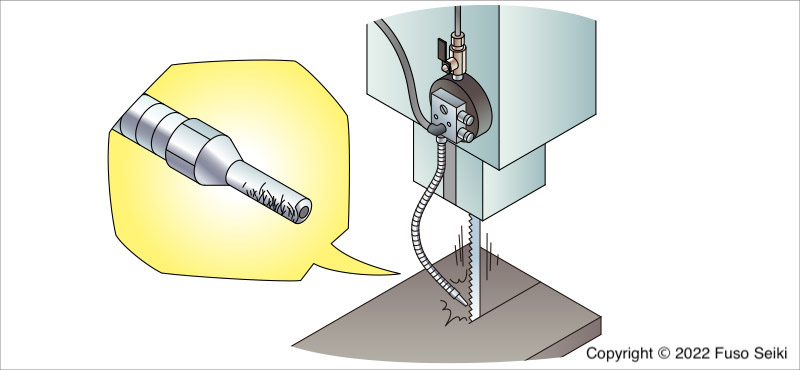Common Problems & Fixes – Magic Cut Not Spraying Properly? Common Causes and Solutions

In our Common Problem & Fixes series we explain the cause and provide solutions to the various product challenges and questions we receive from our customers. In this column we address the problem of the Magic Cut not spraying liquid properly.
Firstly, Check if There is Any Debris Blocking the Line Nozzle
The Magic Cut e-Mist is a minimum quantity lubrication (MQL) near dry cooling device that sprays cutting fluid on the cutting surface of a machine tool. While the Magic Cut e-Mist is a simple, easy-to-use tool, it can sometimes stop spraying after being used for a long time. In this article we review the six most common causes and solutions for when your Magic Cut stops spraying.
Debris is stuck in the liquid line
Debris or cutting fluid deposits are stuck in the air nozzle
The air nozzle is damaged
Another part is blocking the air nozzle
The P-2 O-ring is not properly set on the line nozzle base
The piston valve does not have sufficient grease
Let’s look at these points one by one.
Debris is stuck in the liquid line
The Magic Cut is a cutting fluid cooling device used for cutting machinery. That means the cutting debris produced during the machining process can enter the nozzle. The PTFE tube for the liquid is only 1.5 millimeters in diameter, so even a small amount of debris can block the Magic Cut from spraying.
If your Magic Cut is not spraying, please first remove the line nozzle (flexible nozzle). The line nozzle has a two-layer composition, and the central, narrow PTFE nozzle is the path of the liquid. Use an air-duster to blow air through the line and out the nozzle. When debris is causing the blockage, this is often enough to clear the block.

Another point on the Magic Cut that can become easily blocked is the liquid inlet on the atomizer (rectangular base). Remove the fittings and check for any debris. Use a cotton swab wet with cleaning fluid or paint thinner to remove any debris. Corrosion of the aluminum atomizer and sedimentation of the cutting fluid are the primary causes of blockage at the liquid inlet.
Debris can also enter through the cutting fluid tank. Have you set a strainer or filter onto the tank? A strainer or filter can help prevent debris from entering the Magic Cut (All Lumina gravity feed tanks and pressure feed tanks are equipped with a strainer or liquid filter.)
Debris or cutting fluid deposits are stuck in the air nozzle
If the line nozzle and atomizer inlet are both fine, next check if the air nozzle (the tip of the spray line) has any blockage. Remove the tip and check inside. Do you see any debris? Even a nearly indetectable amount of debris can block the proper spray of liquid. Rinse the tip with paint thinner or cleaning fluid to be sure.
When using emulsion type water-diluted cutting fluid, the liquid itself can cause problems. The liquid components can separate and form a film on the inner surface of the air nozzle (The quality of the liquid determines whether it will separate. Lumina-brand AM-70 oil has no confirmed cases of separation). The film left by the cutting fluid cannot be seen by the naked eye, but you can scratch the inner surface with a thin metal rod or other part and check if any debris emerge. If you find any film, please rinse the part clean with cleaning fluid because it can block Magic Cut from spraying properly. Cutting fluid can also form sediments within the atomizer near the liquid inlet.
The air nozzle is damaged
Damage to the air nozzle is another common cause of the spray being blocked or patchy. The Magic Cut spray nozzle must be placed close to the cutting surface, and the air nozzle can sometimes touch the blade and become damaged. The spray can become blocked or patchy when the nozzle is damaged. Lumina offers replacement air nozzles, so please replace the air nozzle with a new one if it is damaged.

Another part is blocking the air nozzle
A small number of customers place a custom-made aluminum pipe over the air nozzle to change the spray angle or extend its reach. This manner of alteration is not recommended because it can block the air flow and prevent the Magic Cut from spraying properly. Such customization also requires the device to be operated with a high-liquid, high-air pressure mix, which can cause the cutting fluid to splatter around the Magic Cut nozzle.
Air Back Flowing into the Tank is Caused by Missing O-rings
The P-2 O-ring is not properly set on the line nozzle base
The following point does not apply if you have never taken apart the line nozzle since purchasing your Magic Cut, but it is the most common cause of spray problems together with liquid line blockages. If your Magic Cut is not spraying, and air is furthermore entering the cutting fluid tank, there is likely a problem with the Magic Cut’s O-ring.
Please take another look at the diagram of clearing the liquid nozzle with an air duster. The P-2 O-ring is the small O-ring set on the PTFE line. This O-ring is not fixed in place, so it can easily fall off when the line nozzle is detached. The O-ring separates the liquid line from the air line, and air can enter the liquid line if the O-ring is not present. Without the O-ring, liquid that should travel to the nozzle’s tip is instead forced backwards by the air entering the line, causing no liquid to spray from the tip (often the tip only blows air in this case). We offer replacement O-rings, so please purchase a new one if the O-ring is missing.

The final common cause of spray blockage is faulty piston valve movement. The piston valve is a small, plug-shaped piston installed in the atomizer body. When the air is off, this piston blocks the flow of cutting fluid. When air pressure 0.2MPa or greater is applied to the piston valve, it rises to release the flow of liquid. An O-ring is set on the piston valve, but if the grease is lost or degraded on the O-ring, the piston can become stuck, preventing it from opening even when air pressure is applied.
By design, the O-ring should not contact the cutting fluid, so the grease should rarely be degraded or lost. If you have used the Magic Cut for many years, though, liquid can enter the piston valve chamber through abrasion and cause the grease to degrade. If checking the first five points does not fix your Magic Cut, please check the condition of the piston valve. Remove the cutting fluid adjustment knob on top of the atomizer to access the piston valve. Hold the upper portion of the piston valve and move it within the chamber. Please replace the piston valve with a new part if it does not move smoothly and feels like it is catching.
We’ve explained the six common causes of your Magic Cut not spraying liquid properly. Please contact us if you still have trouble after checking these causes. We will carefully inquire on the state of your Magic Cut to help you return it to normal function.

